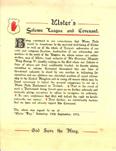








EDCO HISTORY TOPIC 03 Sovereignty & Partition LATER MODERN IRELAND The Educational Company of Ireland Please contact your Local Edco Representative to book a presentation and request a sample copy, Ph: 01-4500611, Email: info@edco.ie, Website: www.edcopublications.ie Other Titles in the Edco Leaving Certificate History Series
NEW Sovereignty and Partition
1912–1949 provides comprehensive coverage of the most popular Leaving Certificate Irish History topic. As both authors are very experienced teachers and examiners, there is an emphasis on historical writing, references to contemporary historians and lots of suitable quotations. Sources are noted to encourage the same by students in their work, particularly in the Research Study Report (RSR).


The textbook is suitable for Ordinary- and Higher-level students, with accessible language used throughout
User-friendly and easy-to-follow layout helps to engage students
Each chapter contains:
Relevance to syllabus
Timeline showing key events, to introduce each section
Full-colour illustrations, photographs and cartoons
A variety of differentiated Questions throughout the chapter:
Source questions on documents called Working with the Evidence


Recap questions to revise material and for comprehension
Consider questions to develop students’ analysis further Debate questions spark discussion in class
To further develop students’ critical analysis, we have a number of questions to think about and discuss in class.
End-of-chapter revision questions based on past Leaving Certificate questions
Extra Documents Based Question–style questions, to provide students with content to practise evaluating sources
Key personalities and key concepts are clearly explained, with particular focus suited to Ordinary Level. These are incorporated into the chapters
Key terms, which make the text more accessible
A Bibliography provides a useful list of websites, journals, newspaper articles and books for further reference

Digital Resources
Teachers can access the Sovereignty and Partition 1912–1949 interactive e-book at www.edcolearning.ie






› FREE Editable PowerPoint Presentations are also available




TOPIC 03 Sovereignty & Partition 1912-1949
www.edcopublications.ie
EDCO HISTORY: SOVEREIGNTY AND PARTITION 6 7 02 THE RULE 1912–1914 THE IMPACT OF WORLD imagine no length of resistance to which Ulster can go in which would not be prepared to support them (Atlas, Callanan p.142) This defiance really shocked Asquith and Redmond. The bill was greeted by considerable sectarian unrest in Ulster. There were riots and 2,500 Catholic and rotten Protestant workers were forced to leave the Belfast dockyards at the end of June. (The term rotten Protestants was used by unionists to describe Protestant Home Rulers.) Violent clashes erupted on 14 September 1912 between Catholic and Protestant fans at a football match in Belfast between Catholic Celtic and Protestant Linfield clubs. These developments alarmed Carson, who believed such violence weakened the unionist case. He was anxious to find a means to control and focus popular feeling. Craig came up with a solution. The official unionist response would include a mass petition and the formation of a volunteer force. Ulster Day: Ulster Solemn League and Covenant Craig drew up the Ulster Solemn League and Covenant, based on the Scottish covenants of the seventeenth century. The covenant deliberately echoed the Old Testament’s account of God’s covenant (contract) with His Chosen People. Many Ulster unionists regarded themselves as God’s chosen people, under threat from their enemies. They would sign the covenant on ‘Ulster Day’, 28 September 1912, declaring their commitment to the opposition to Home Rule. 2.2 Reaction to the Third Home Rule Bill Conservative and unionist reaction to the Home Rule Bill The Conservative Party was firmly opposed to Home Rule. It was one of the few issues on which all the party could agree. Furthermore, their new leader (since 1911), Andrew Bonar Law had strong family ties with Ulster and with unionism. In April 1912, he addressed unionists in Derry: ‘Once again, you hold the pass for the empire. You are a besieged city … The government by their Parliament Act have erected a boom against you, a boom to cut you off from the help of the British people. You will burst that boom. (Lyons, p.301) As the fight against Home Rule had been greatly weakened in parliament, Carson and Craig had to mobilise resistance in Ulster. The Lords’ veto could only now delay Home Rule’s passage through parliament. In Belfast on 9 April, Bonar Law had promised Conservative Party support to unionist resistance. Mass demonstrations were held all over Ulster and in Britain. A key aim was to mobilise popular opinion in Britain against the proposal of Home Rule for Ireland. Bonar Law on 29 July declared at Blenheim: can 18 June Partition proposed possible solution Irish question the House Commons Summer riots 28 September Ulster Day: signing of the Ulster League and Covenant 16 January Home Rule Bill in the House of for 30 January Home Rule Bill rejected in the House of 31 January Volunteer founded July Home Bill passed the House Commons second 1912 1913 1 Who does the person represent? Where he headed? 3 Explain what the shield represents and why he needs 4 Do you think the cartoonist approved of the shield? Support your answer by referring to the cartoon. Bonar Law references what event in Derry in 1689? Recap 1 In this period, which British political party usually supported Home Rule? Which party usually opposed it? Give two reasons why some British voters opposed Home Rule for Ireland. Give two reasons why some supported it. Why did the House of Lords veto ‘the People’s Budget’? 4 Why was the Parliament Act of 1911 significant for Ireland? Consider Why were Ulster unionists so against the Parliament Act 1911? Why did the Liberal Party change its attitude to Home Rule between 1906 and 1911? Debate ‘The Liberal Party was committed to Home Rule for Ireland.’ Discuss. m Andrew Bonar Law (1858– 1923): Born in Canada with family in Ulster, he was reared in Scotland. He became leader of the Conservative Party in 1911. As leader of the opposition, he campaigned against the Third Home Rule Bill. m Leaders walking in to sign the covenant: Lord Charles Beresford, Frederick Smith (founder of the UVF) and Edward Carson head a demonstration against Home Rule at City Hall, Belfast, for the signing of the Covenant on Ulster Day, 28 September 1912. m Edward Carson (1854–1935): A Dublin-born lawyer, he was MP for Trinity College Dublin from 1892 to 1918 and for Duncairn in North Belfast from 1918 to 1921. He led the Unionist Party from 1910 until 1921. As southern unionist, he was personally opposed to partition but eventually saw the exclusion of six counties as the only workable compromise. m Ulster Solemn League Covenantand 1900 1901 1902 1903 1904 1905 1906 1907 1908 1909 1910 1911 1912 1902 1904 1907 1910 1912 Relevance to syllabus The Home Rule 1912–1914 The impact of World War Key concepts: partition; Ulster Unionism; allegiance. Key personality: James Craig (see Chapter 10) Home Rule: a form of self-government. Ireland would remain in the United Kingdom but have local parliament to deal with Irish affairs such as health, education and transport. Balance of power: when a large party fails to achieve a majority and needs the support of a smaller party to form government. The smaller party has the balance of power, as their support determines who can form a government. Parliament Act an Act that removed the veto of the House of Lords. The Lords could now only delay bills passed in the House of Commons. Sectarian violence: violence caused by religious conflict between groups usually living in the same state, e.g. violence between Catholics and Protestants in Northern Ireland. Allegiance: loyalty and devotion to a cause, person or movement. Solemn League and Covenant: pledge taken by Ulster unionists to resist the passing of Home Rule, by whatever means necessary. Ulster Volunteer Force (UVF): a paramilitary (armed) group set up by Ulster unionists to defend them from the threat of Rule. Irish National Volunteer Force (IVF): a paramilitary group set up by nationalists to ensure the implementation of Home Rule. Mutiny: refusal to obey the orders of the authorities (usually refers to sailors or soldiers). IPP: Irish Parliamentary Party (Home Rule Party). Partition: would be divided. Some Ulster counties would remain in the United Kingdom and the rest of Ireland would have its own parliament in Dublin. 2.1 Towards Home Rule Introduction The Home Rule Party split in 1890. When it reunited under John Redmond and John Dillon in 1900, the prospects for Home Rule looked poor. The conflicting views of the British Liberal government, the Conservative opposition, Home Rulers and Ulster unionists made the granting of Home Rule complex issue. Behind the scenes in the Houses of Commons and Lords, talks (some secret, some not) were being conducted between British politicians and Irish politicians, both unionist and nationalist. They sought possible solutions to the Irish question, which was more and more to become the Ulster question. British attitudes towards Home Rule for Ireland Many ordinary people in Britain opposed the idea of Home Rule for Ireland. There was concern about the security of Ireland. Many feared that Ireland could be used as a backdoor to invade Britain. The defence of Britain would remain key concern in all Anglo-Irish relations. Others had religious concerns that Home Rule would not protect the Irish Protestant minority. still believed old colonial idea Ireland was not rule itself. Finally, there was opposition from those who believed it would weaken the Empire. In parliament the unionists since 1886. It adopted the title ‘Conservative and Unionist Party’ in 1912. On the other hand, there was also support for Home Rule. Bannerman, won huge majority. This election became known as ‘the Liberal Landslide’. 156 Party Parties Conservative the 1906 election Home Rule reunited under put the Liberals government 29 April The People’s presented January–February General the support of returned to power February Carson accepted the Unionist Party 3–9 General Liberals returned to power Parliament 23 unionist demonstration Parliament 11 April Third introduced House 2.1 Towards Rule Reaction to the Home Rule Bill: unionist and nationalist responses The Ulster question 2.4 The impact of World War The Home Rule Years: 1912–1914 and the Impact of World War I 22 22 13 02 Towards Home Rule 2.2 Reaction to the Third Home Rule Bill: unionist and nationalist responses 2.3 The Ulster question 2.4 The impact of World War THE HOME RULE YEARS: 1912–1914 AND THE IMPACT OF WORLD WAR Relevance to syllabus The Home Rule Bill 1912–1914 The impact of World War Key concepts: partition Ulster Unionism allegiance Key personality: James Craig (see Chapter 10) Home Rule: a form of self-government. Ireland would remain in the United Kingdom but have local parliament to deal with Irish affairs such as health, education and transport. Balance of power: when a large party fails to achieve a majority and needs the support of a smaller party to form government. The smaller party has the balance of power, as their support determines who can form a government. Parliament Act 1911: an Act that removed the of the House of Lords. The Lords could now only delay bills passed in the House of Commons. Sectarian violence: violence caused by religious conflict between groups usually living in the same state, e.g. violence between Catholics and Protestants in Northern Ireland. Allegiance: loyalty and devotion to cause, person or movement. Solemn League and Covenant: pledge taken by Ulster unionists to resist the passing of Home Rule, by whatever means necessary. Ulster Volunteer Force (UVF): a paramilitary (armed) group set up by Ulster unionists to defend them from the threat of Home Rule. Irish National Volunteer Force (IVF): paramilitary group set up by nationalists to ensure the implementation of Home Rule. Mutiny: refusal to obey the orders of the authorities (usually refers to sailors or soldiers). IPP: Irish Parliamentary Party (Home Rule Party). Partition: Ireland would be divided. Ulster counties would remain in the United Kingdom and the rest of Ireland would have its own parliament in Dublin. Home Rule reunited under John Redmond united unionist Ulster January–8 February General Election: Landslide’ Liberals back 29 The People’s presented January–February General the support of the power February accepted leadership Unionist Party December Election: Liberals again power 18 August September Ulster unionist against 11 April introduced 1900 1901 1903 1904 1905 1906 1907 1908 1909 1910 1911 1912 ⇑ John Dillon, John Redmond and Joe Devlin, the IPP.






















